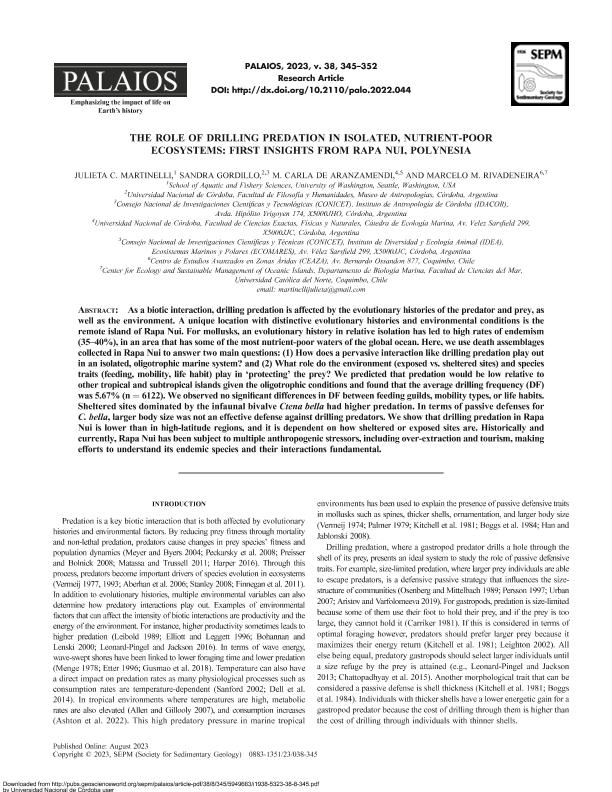Mostrar el registro sencillo del ítem
dc.contributor.author
Martinelli, Julieta C.
dc.contributor.author
Gordillo, Sandra

dc.contributor.author
de Aranzamendi, Maria Carla

dc.contributor.author
Rivadeneira, Marcelo M.
dc.date.available
2024-02-14T14:06:11Z
dc.date.issued
2023-06
dc.identifier.citation
Martinelli, Julieta C.; Gordillo, Sandra; de Aranzamendi, Maria Carla; Rivadeneira, Marcelo M.; The role of drilling predation in isolated, nutrient-poor ecosystems: first insights from Rapa Nui, Polynesia; Society for Sedimentary Geology; Palaios; 38; 5; 6-2023; 345-352
dc.identifier.issn
0883-1351
dc.identifier.uri
http://hdl.handle.net/11336/226863
dc.description.abstract
As a biotic interaction, drilling predation is affected by the evolutionary histories of the predator and prey, as well as the environment. A unique location with distinctive evolutionary histories and environmental conditions is the remote island of Rapa Nui. For mollusks, an evolutionary history in relative isolation has led to high rates of endemism (35-40%), in an area that has some of the most nutrient-poor waters of the global ocean. Here, we use death assemblages collected in Rapa Nui to answer two main questions: (1) How does a pervasive interaction like drilling predation play out in an isolated, oligotrophic marine system? and (2) What role do the environment (exposed vs. sheltered sites) and species traits (feeding, mobility, life habit) play in 'protecting' the prey? We predicted that predation would be low relative to other tropical and subtropical islands given the oligotrophic conditions and found that the average drilling frequency (DF) was 5.67%(n 6122).We observed no significant differences in DF between feeding guilds, mobility types, or life habits. Sheltered sites dominated by the infaunal bivalve Ctena bella had higher predation. In terms of passive defenses for C. bella, larger body size was not an effective defense against drilling predators.We show that drilling predation in Rapa Nui is lower than in high-latitude regions, and it is dependent on how sheltered or exposed sites are. Historically and currently, Rapa Nui has been subject to multiple anthropogenic stressors, including over-extraction and tourism, making efforts to understand its endemic species and their interactions fundamental.
dc.format
application/pdf
dc.language.iso
eng
dc.publisher
Society for Sedimentary Geology

dc.rights
info:eu-repo/semantics/openAccess
dc.rights.uri
https://creativecommons.org/licenses/by-nc-sa/2.5/ar/
dc.subject
POLYNESIA
dc.subject
OLIGOTROPHY
dc.subject
MURICID
dc.subject
NATACID
dc.subject
ENDEMISM
dc.subject.classification
Zoología, Ornitología, Entomología, Etología

dc.subject.classification
Ciencias Biológicas

dc.subject.classification
CIENCIAS NATURALES Y EXACTAS

dc.title
The role of drilling predation in isolated, nutrient-poor ecosystems: first insights from Rapa Nui, Polynesia
dc.type
info:eu-repo/semantics/article
dc.type
info:ar-repo/semantics/artículo
dc.type
info:eu-repo/semantics/publishedVersion
dc.date.updated
2024-02-07T14:50:15Z
dc.journal.volume
38
dc.journal.number
5
dc.journal.pagination
345-352
dc.journal.pais
Estados Unidos

dc.journal.ciudad
Lawrence
dc.description.fil
Fil: Martinelli, Julieta C.. University of Washington; Estados Unidos
dc.description.fil
Fil: Gordillo, Sandra. Consejo Nacional de Investigaciones Científicas y Técnicas. Centro Científico Tecnológico Conicet - Córdoba. Instituto de Antropología de Córdoba. Universidad Nacional de Córdoba. Facultad de Filosofía y Humanidades. Instituto de Antropología de Córdoba; Argentina
dc.description.fil
Fil: de Aranzamendi, Maria Carla. Consejo Nacional de Investigaciones Científicas y Técnicas. Centro Científico Tecnológico Conicet - Córdoba. Instituto de Diversidad y Ecología Animal. Universidad Nacional de Córdoba. Facultad de Ciencias Exactas Físicas y Naturales. Instituto de Diversidad y Ecología Animal; Argentina
dc.description.fil
Fil: Rivadeneira, Marcelo M.. Universidad de La Serena; Chile
dc.journal.title
Palaios

dc.relation.alternativeid
info:eu-repo/semantics/altIdentifier/url/https://pubs.geoscienceworld.org/palaios/article/38/8/345/627984/THE-ROLE-OF-DRILLING-PREDATION-IN-ISOLATED
dc.relation.alternativeid
info:eu-repo/semantics/altIdentifier/doi/http://dx.doi.org/10.2110/palo.2022.044
Archivos asociados
